Old Fashioned 50s Dresses Old Fashioned 50s Dresses
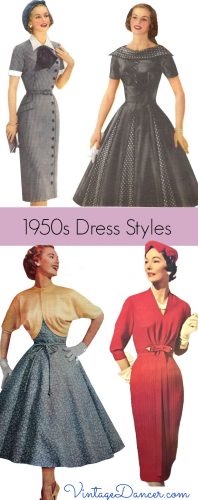
1950s Clothes Styles
During the 1950s, women wore dresses like we wear t-shirts and jeans today. A vintage 1950s wearing apparel was a closet staple and came in a wide multifariousness of colors and ii master silhouettes. Shoulders were narrow and soft. The waist had to be tiny and pulled in — a "wasp" waist. A tight bodice came to the natural waist or slightly higher, where the skirt took over. The skirt is where the two silhouettes of the 1950s emerged. The full swing skirt and the tight pencil skirt. They were complete opposites but both were worn equally by women in the 1950s. All vintage 50s dresseswere variations of these ii shapes.
Vintage 50s Dress History
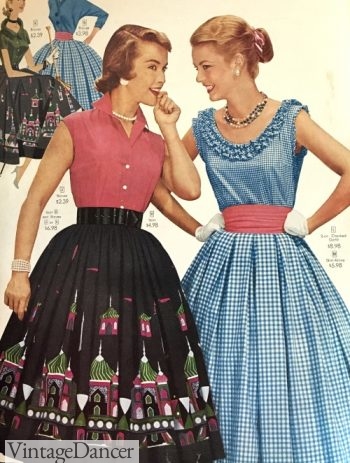
1956 Summer Skirts and Dresses
Vintage 1950s dress fabrics were endless and made a wearing apparel more coincidental or elegant depending on where it was worn. Cotton was used for leisure clothing, mostly in shirtwaist dresses – the favorite house wearing apparel. Wool and linen were popular for day, as were the new synthetics rayon and polyester. Tweed, like wool and acetate blends, was in vogue for fall in the mid '50s. Silk shantung could be used to make a dress a trivial bit more dressy for dinners out.
Colors went from light and girly to assuming – pastels were very popular in all clothing, and dresses were also done in jewel tones similar majestic purple, ruddy cherry, navy, and emerald green. Allover patterns were used even more frequently – in that location were pocket-size or big florals, plaids, polka dots, gingham checks and stripes, as well as novelty prints with science, nautical, tropical, or western themes. It was very chic to wear prints from famous artists' works. Whether all over or just around the skirt edge, prints made a dramatic statement.
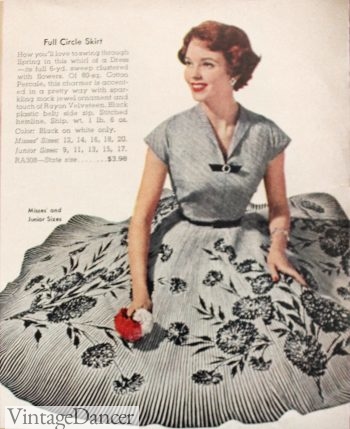
1958 Border print dress made with a total vi yards for the skirt!
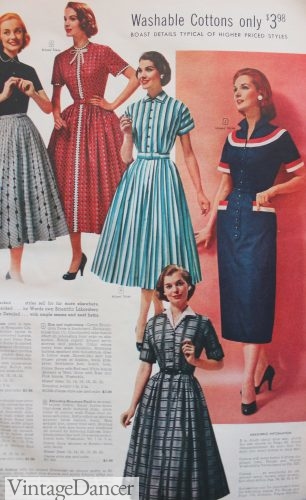
1957, Various neckband treatments, prints and patterns create diversity in 1950s dress styles.
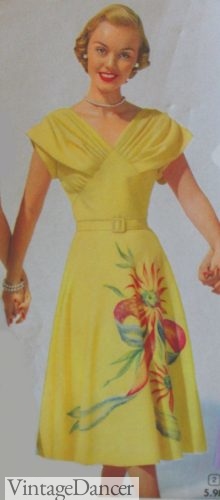
1951 Tropical Print Dress
50s dresses, and women's clothes in general, were rarely left plain. Fancy collars such as Peter Pans, wings, mandarin, middy, homo-tailored, detachable, pilgrim, and shawl collars added drama to the neckline, while trims of complect-piece of work or piping on large pockets and shirt cuffs contrasted with the body color. Buttons were large, becoming function of the statement, not but utility.
Summer dresses exposed more arm than ever before. Halter tops and sleeveless shirt dresses immune the sun to buss the shoulders. Tropical prints, inspired by Hawaii and other sunny vacation spots became even more pop in the 1950s, along with "Tiki" parties. The strapless evening gown was more widely accustomed, specially for teens attention prom.
Shop now for 1950s style dresses.
1950s Dresses: The "New Expect"
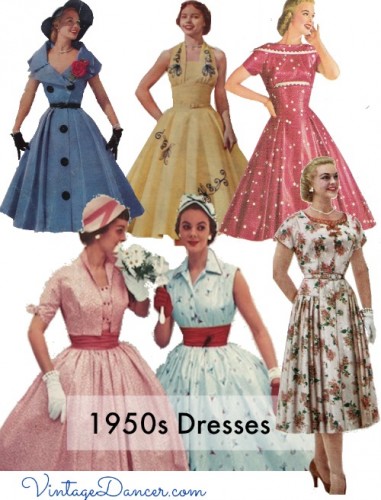
Full Dresses
Dior'southwardNew Look total-skirted apparel is the nearly iconic vintage 1950s wearing apparel way, specially during the showtime half of the decade. The bodice was very fitted with a full circle or gathered swing skirt ballooning out from the natural waistline. The fullness was made by gathering or pleating upwards to six yards of lightweight fabric. The skirt could be worn with a petticoat or 2 underneath to give it added fullness or with a thin slip for easier motion. These dresses are often chosen swing dresses.
As for the bodice, the options were vast. It was usually tailored and often decorated with large buttons and bows. Necklines could be scooped, v-cervix, boat-neck, square-cervix, or sweetheart. There were also collars on these dresses. Wearing apparel collars could exist large and pointed, small round Peter Pan or Bertha. Bertha collars were very large and round at the bottom, they fit around the unabridged cervix like a bib. Collars were oft done in white to contrast with the residuum of the clothes. Blackness and white were an peculiarly common pairing.
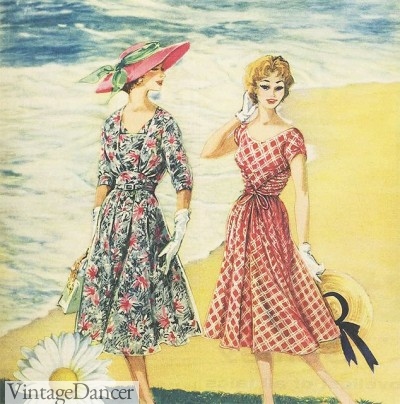
Summertime Nylon Wrap Dresses
For a less tailored and less popular look, the bodice fabric was sometimes left drapey, with a wrap top that crossed over in the front or gathering downwardly the sides. Halter tops were worn in the summertime, with a Five-neckline and 2 thick straps tied behind the neck. Sleeveless dresses were also very popular, but sleeves could be very short cap sleeves or elbow length. Brusk puff sleeves and dolman sleeves were also used on full-skirted dresses. Needless to say, in that location was no single style of sleeve or neckline that wasn't role of the vintage '50s dress fashion.
1950s Shirtwaist Dress / Housewife Dress
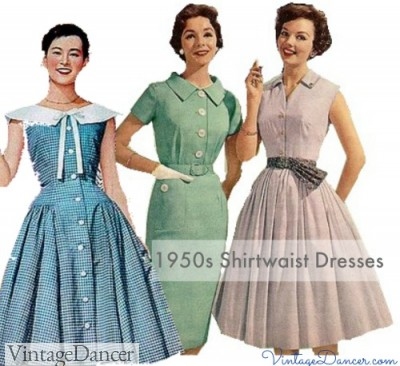
1950s Shirtwaist Dresses
The shirtwaist apparel was a very pop version of the full-skirted wearing apparel. Shirtwaist dresses, or shirtwaists for short, had a fitted push button-down top, like a blouse, that ended at the waist. The buttons would extend a little bit below the waist for getting in and out of the dress. A full gathered/pleated or circumvolve skirt completed the bottom. Sleeves were often cap, brusk or elbow length, and could also be full long sleeves. Sleeves were cuffed at the ends. The collars were normally pointed or small peter pan collars for most house dresses.
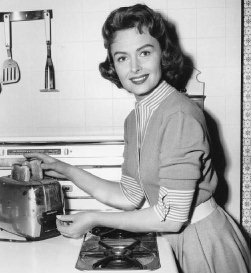
Donna Reed wearing a Shirtwaist Dress
The 1950s shirtwaist dress style was the uniform of all housewives, and Donna Reed was the mascot. Information technology was like shooting fish in a barrel to put on, like shooting fish in a barrel to launder, and easy to move in. With a make clean, pressed apron over the clothes, information technology could exist worn all week earlier cleaning was necessary. Shirtwaists could be a solid colour but were usually in a cotton percale impress or gingham. Gingham check was introduced in 1950 and became wildly popular for house dresses likewise equally shirts, play suits, capri pants, and skirts. It was function of the "All American Western country girl" wait of the '50s. Pink gingham was the almost popular color.
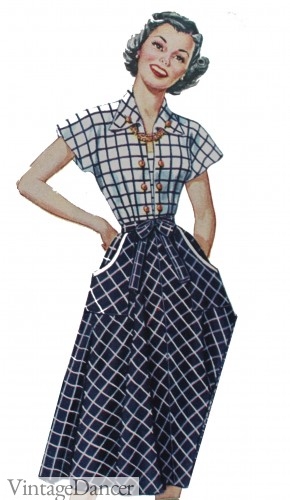
Windowpane Print Shirtwaist Dress
"Someday yous will be a charming fiddling married woman in a cottage built for ii. Your husband will enjoy looking at you across a breakfast table each morning in a frock as fresh every bit a daisy. When he leaves for the office, permit him comport with him a vision of the petty wife as pert and efficient in her becoming firm dress as the office girls in their trim tailleurs." – Clothes with Character, by Hazel Thompson Craig
The shirtwaist wearing apparel made its way to eveningwear, likewise. When made of textured solid colors in Rayon, taffeta, or silk and embellished with lace or bead work or rhinestones, the shirtwaist became glamorous.
Shop shirtwaist dresses and other 1950s day dresses.
1950s Coatdress
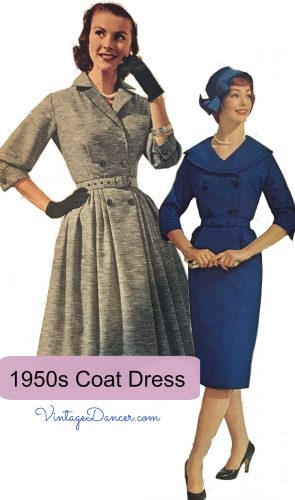
1950s Glaze Dresses
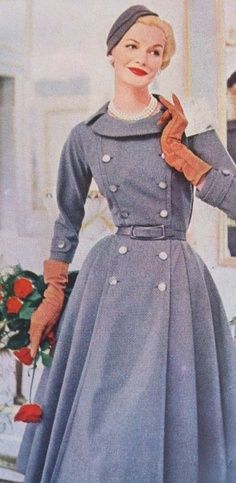
Glaze Dress
The coatdress was another full-skirted version. Information technology was slightly similar to the shirtwaist clothes, simply had the styling of a long coat instead of a shirt. These dresses buttoned all the style downwards to the bottom of the skirt and had no back zipper. Buttons were oftentimes oversized, and the collar was larger, resembling that of an overcoat. Shoulders on coatdresses could exist slightly more than padded, and sleeves were usually long or dolman shape. They came with a matching cocky fabric chugalug. Because of the heaviness of the large collars, buttons and sleeves, coatdresses were worn the nearly oftentimes in fall and winter.
1950s Hostess Dress
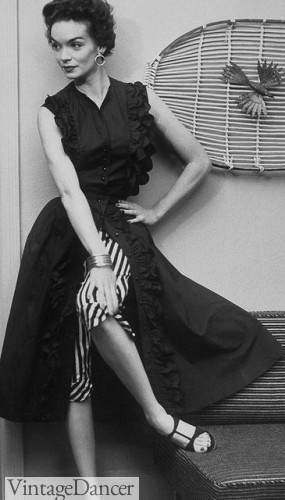
Hostess gown turned pants ensemble
Part wearing apparel, function capri pants. The 1950s hostess gown was a big circle skirt with an opening down the front end, revealing slim fitting capri or cigarette pants underneath. Lucile Ball wore them often in I Love Lucy, and since then women embraced this more coincidental yet oh-then-glamorous fashion for entertaining in the home. Some very fashion frontwards women tossed out the overskirt and but wore the pants.
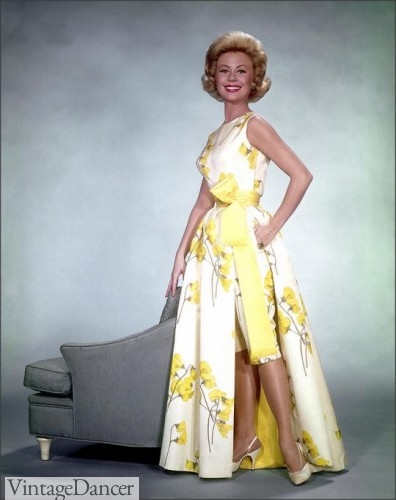
Tropical hostess gown and culotte shorts
1950s Sheath Dress: Pencil and Jerk Dresses
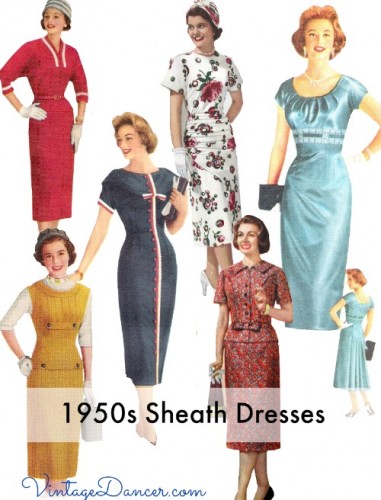
1950s Slim Fitting Sheath Dresses
The other silhouette of the 1950s dress was somewhat opposite of the total skirted style, although the chief features of the New Wait remained. Dior one time once again led the way for subtle variations of the sheath wearing apparel, naming his collections Corolla, Tulip, H, A and Y Lines after the shape of the dress.
The bodice was the same every bit a 1950s swing clothes– tailored, fitted and nipped in at the waist. But the skirt of this type of wearing apparel was very closely fitted to the body from the waist downwardly. The tighter and straighter, the better. This was the lean sheath clothes, likewise known as the jerk dress today. In their snuggest class, they have become symbols of the modern Pinup movement. Shop pinup dresses here.
Jerk dresses zipped upwardly the back. The bodices were often decorated with small-scale collars and bows, and the skirts oft featured welt pockets on the sides or two oversized front end patch pockets. Big buttons could exist used to decorate the front, too.
The bodice was ordinarily tailored and had either sleeveless, short cap or elbow-length sleeves. The neckline was often a high scoop or boat-cervix. The high neckline with a long direct skirt gave the illusion of slenderness. The skirt was what we would call a pencil brim today. It curved over the hips and tapered down to mid-calf. At that place was a vent or kick-pleat added to the back of the skirt and then the wearer was able to walk.
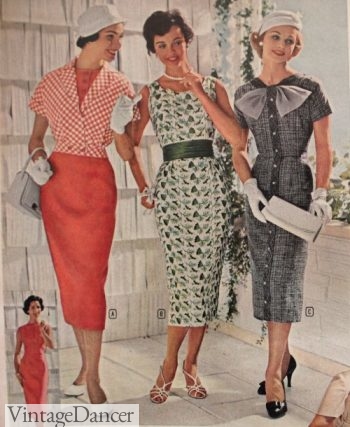
1958 Leap Sheath Dresses
In 1952, Faddy commented, "We want skirts nosotros can stride out of an car in without splitting their sides, sleeves that can accomplish for a telephone without straining their shoulders."
Comfort while remaining classy was what women demanded. While Paris lead the fashion with blueprint, it was American manner houses that made them more comfortable. Despite how tight they looked in magazines, on existent women they were a tad roomier.
There were 2 lengths of skirts. The shortest, ending only beneath the knee joint had a kick pleat half style up the thigh. Information technology was the easiest length to walk in. The longer mid calf sheath with decorative kick pleat came upward to the knee but was difficult to walk in. Gliding in small steps like a geisha was about all you lot could practice in them. Sheath dresses were sexy. Paired with wiggle enhancing high heels, they fabricated girls into women.
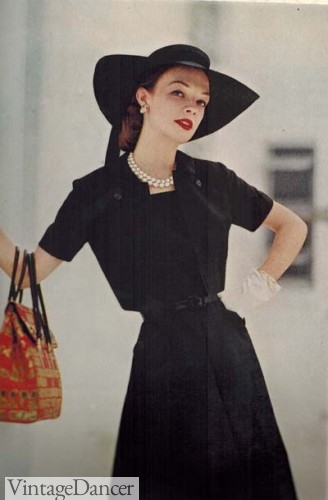
Little Black Wearing apparel
Every woman, teens included, had to accept at least one little blackness dress in her wardrobe. This meant a 1950s sheath dress. It was the perfect dress to wearing apparel up with pearls, or dress down with a colorful scarf. When you didn't know what to wear, you wore your little blackness wearing apparel. Going to a cocktail political party meant half the attendees were wearing a piffling black dress, likewise. They could exist fitted, bloused, double-breasted or with a sexy deep V neckline. An alternative to black was navy blueish for evening habiliment.

1959 Cocktail dresses
1950s Bell Wearing apparel
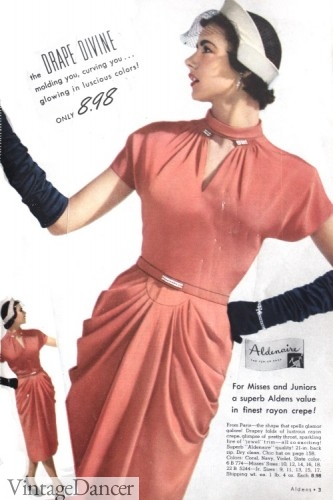
1951 Bong Clothes
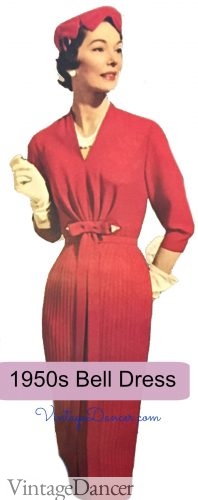
1959 Bong Dress
A tendency that emerged towards the end of the decade was the bong dress – a kind of combination of the two skirt shapes. The bodice was tailored and fitted as usual, and could follow whatever of the bodice styles plant in other dresses. All the same, the skirt started out gathered at the waist, puffed out effectually the hips, and so tapered back in to exist fitted at the calf, creating a bell-shaped skirt. They were not flattering on most body shapes since they accentuated the hips and thighs.
1950s Jumper Dress
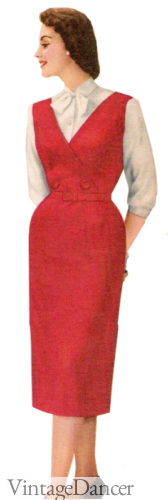
1957 Jumper Apparel
Some other conduct over fashion from the 1940s was the jumper dress. Loved past girls and teens, the women's version was usually a deep Five-neckline worn with a blouse underneath. The shoulder straps were wide. The skirt could exist either exist full or pencil, with the pencil shape being more mutual- more womanly.
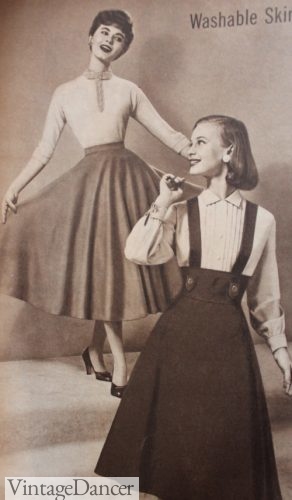
1957 jumper dresses with swing skirts
The younger version was a full skirt with a loftier waist that would end just beneath the bust or had a bib front, like overalls. Two narrow straps buttoned on the front and criss-crossed at the dorsum. The main difference between the '40s version and '50s version was the fullness of the skirt. Since immature teens wanted to dress more sophisticated the jumper apparel was increasingly going out of style by the mid '50s.
1950s Chemise Dress
"Sack the Sack!" "Bring Back Curves!"
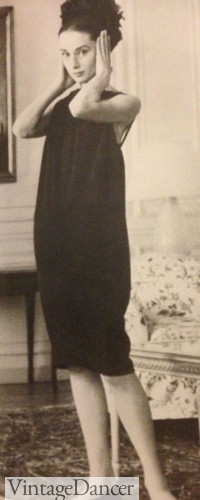
Blackness Chemise Wearing apparel
In 1957, the Chemise or spindle clothes was more joke than fashionable attire. The fancy name was Chemise, merely the street name was sack, bag, or shoplifters delight. They fit like a tube that ballooned out in the center. Its non-form shaping qualities quickly made it a freak fad that women and especially men hated. Simply stick thin women could look good in information technology. Women with hips looked even wider in information technology. Even a wide belt effectually the hips didn't help at all, nor did gathering the fabric to the back and accenting with a large bow. Oh, the comical horrors! By 1960, the sack dress became a straight shift dress with a shorter hemline that women (and men) liked improve.
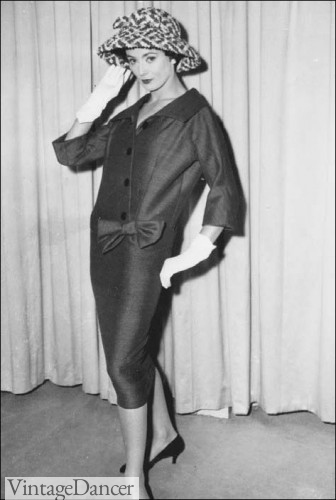
Dior's Chemise Dress
Despite its ill-fitting issues, it was a dress that well-nigh every woman bought in 1958. Information technology sometimes had a white collar and matching bow at the bend of the back. It buttoned down the back, too, requiring help to put information technology on. The perfect length was just below the knee. Whatever longer and information technology really did look like a tube of lipstick.
"I believe the chemise dress was one of the ugliest style foisted upon American women by designers. The dress overlooked the bust line and the waist, dropping straight down until information technology fit tightly over the buttocks. My chemise was xanthous, and I looked like a waddling stick of butter." – Carolyn Sucker, What We Wore
1950s Trapeze Clothes
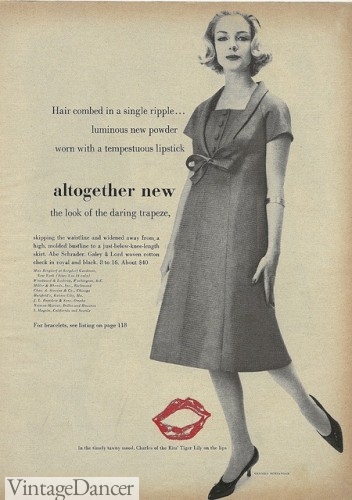
1959 Trapeze Wearing apparel
A cousin of the hated Chemise dress was Dior's Trapeze wearing apparel. The superlative was fitted to simply under the bust and flared out in a slim A-line to the genu. It was more than successful than the Chemise since information technology accented the bust merely hid the hips and thighs.
Both the Chemise and Trapeze were brusque-lived fads in 1958. By 1959, no one dared to be seen in them.
Not all was lost. Past the mid to late 1960s, the trapeze wearing apparel came back again with a bit more fanfare than before.
More 1950s Clothes Styles
While the above dresses capture the main silhouettes of the 1950s, in that location were even more dresses that had specific purposes, themes, or prints worth looking into:

1959 Plus Size Floral Clothes past Lane Bryant
- 1950s Plus Size Fashions – The plus size fashion industry had been booming since the 1920s. By the 1950s, nearly shops and mail order catalogs featured clothing in expanded sizes. Dresses were designed to fit and flatter a diverse range of trunk types. Shop 1950s dresses in 2XL to 6XL sizes.
- 1950s Floral/Tropical Dresses – The influence of Hawaiian prints and other tropical summer destinations fabricated an impact on 1950s dress fashion. Read a bit more than about these designs here.
- Polka Dot Dresses – The vintage fashion world was obsessed with polka dots. From the turn of the century to the late 1950s, polka dots were a very popular print. Both big dots and little dots made up most youthful dress designs. See the history, or shop 1950s polka dot dresses.
- Sailor Dresses / Nautical Dresses / Patriotic Dresses – Red, white and bluish was a common color combination. The 1950s added anchors, sailor stripes, and other seaside symbols for fifty-fifty more playful clothing. Shop these looks.
- 1950s Prom Dresses/Formal Dresses – Glamorous eveningwear was over the peak in the 1950s. Both floor length ballgowns and shorter tea length party dresses used voluminous petticoats, layers of tulle and sheer fabrics, and feminine details to bring the doll look to every party, prom or evening affair. Learn more almost these amazing styles and shop for your ain 1950s party dress.
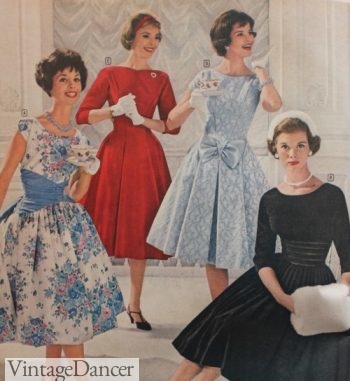
1959 Party Dresses
What vintage 50s dress is your favorite?
Notice 1950s style polka dot dresses, day dresses, floral dresses, Rockabilly dresses, and more than. For 50s dresses under $l in the USA and U.k., look hither. Here are some new 1950s style dresses to go you lot started:
0 Response to "Old Fashioned 50s Dresses Old Fashioned 50s Dresses"
Post a Comment